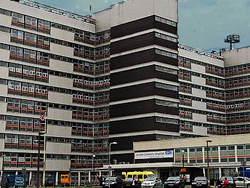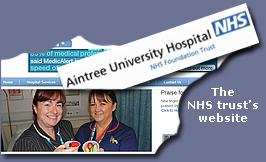Aintree University Hospital in Fazakerley, Liverpool had 236 more patients die than predicted in the past financial year reports the Liverpool Echo.
The hospital was previously reprimanded by the Care Quality Commission (CQC) over this death rate, but has now been urged to launch an investigation after new statistics revealed a persistently high death rate.
 Further, amongst many patients relatives, there still remains the belief that some patients, especially the elderly, are given rushed diagnosis of imminent deterioration and put on 'end of life' procedures despite denials when questions are asked by relatives. The suspicion is that the now allegedly withdrawn 'Liverpool Pathway' is still being used by clinicians at the Hospital, but no longer referred to in patient notes. In other words the process still remains in use, but by any other name.
Further, amongst many patients relatives, there still remains the belief that some patients, especially the elderly, are given rushed diagnosis of imminent deterioration and put on 'end of life' procedures despite denials when questions are asked by relatives. The suspicion is that the now allegedly withdrawn 'Liverpool Pathway' is still being used by clinicians at the Hospital, but no longer referred to in patient notes. In other words the process still remains in use, but by any other name.
But the concerns over the Merseyside hospital does not stop there. In December 2013 Hospital bosses were issued with a formal warning after failing to meet three out of seven national standards in an inspection by the Care Quality Commission (CQC):
During their inspection and assessment of the Hospital in September 2013 over a 3 day period, they found delays in admitting patients due to a lack of bed space, patients with dementia not being properly assessed and unsatisfactory complaint and safety monitoring systems.
Malcolm Bower-Brown, of the CQC, said: "We will not hesitate to take further regulatory action, should this be necessary to ensure patients receive the quality of care and support they are entitled to expect."
The trust is also being investigated by regulator Monitor for failing to meet its superbug and A&E waiting time targets.
The figures show that Aintree University Hospital NHS Foundation Trust in Fazakerley had 236 more patients die than predicted during the past financial year.
Their mortality rate was 13% more than expected between July 2012 and June 2013. The trust also had high death ratios the previous year when 274 (16%) more patients than expected died."
The Echo news item continues:
" The hospital has been placed in a batch of six hospitals across the county earmarked as needing further scrutiny.
Bosses from NHS England insist the higher-than-expected mortality rate does not mean the hospital is unsafe but does warrant further attention.
 Dr Mike Durkin, director of Patient Safety at NHS England, said:
Dr Mike Durkin, director of Patient Safety at NHS England, said:
“A higher than expected mortality rate shown by this indicator does not in itself tell us that a hospital is unsafe.
It is, however, a warning light and a signal to the trusts that they should immediately investigate further to identify the reasons for the high mortality rate and resolve any associated quality issues that may have contributed.”
The article further concludes:
"The figures were put together by the Health and Social Care Information Centre. From July 2012 to June 2013, Fazakerley was predicted to have 1,794 patients die – in fact there were 2,030 deaths.
Meanwhile, during the previous period July 2011 to June 2012, the hospital was predicted to have 1,665 deaths but actually had 1,939."
However, high death rates are not the only thing concerning the users of the hospital; infection rates are still giving cause for concern as this BBC News report in June of 2013 makes clear:
"The Aintree University Hospital NHS Foundation Trust is one of the first hospitals investigated under a new regime by the regulator, Monitor.
The trust is also reported to have missed referral-for-treatment targets.
A trust statement said it was disappointed and concerned at its performance.
 Monitor said it took the decision about the Aintree trust after breaches of its C. difficile, MRSA, A&E four hour waiting time and referral-for-treatment targets raised concerns about governance at the trust.
Monitor said it took the decision about the Aintree trust after breaches of its C. difficile, MRSA, A&E four hour waiting time and referral-for-treatment targets raised concerns about governance at the trust.
The watchdog is investigating the trust under its new licence regulatory regime, which started in April.
Yvonne Mowlds, regional director at Monitor, said: "We are investigating at an early stage to find out why these problems have occurred.
"Monitor has not yet reached a view as to whether there has been any breach of the licence conditions."
Catherine Beardshaw, chief executive of the trust, said the board is "disappointed and extremely concerned" about its overall infection control performance. "We have revised our action plans and have now seen a reduction in the number of C. difficile cases reported in the last two months," she said.
Ms Beardshaw said the trust will meet Monitor in the coming weeks."
Source: Liverpool Echo / BBC News